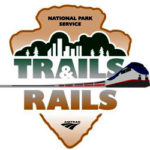A Brief Discussion of the Genesis of the Coast Rail Line, the Pacific Surfliner and Related Subjects by Bruce Morden (Lightly edited by G. Stephens)
The Pacific Surfliner is a new train dating from 2000. It currently runs from San Diego to San Luis Obispo. Originally the portion from San Diego to Los Angeles belonged to the Santa Fe San Diegan. The line from Los Angeles to San Luis Obispo belonged to the Southern Pacific who ran several different trains over the years. When Amtrak took over passenger service on May 1, 1971, they continued to run the San Diegans from LA to San Diego and the Coast Starlight from Los Angeles to Seattle. Later [1988 ed.] Amtrak extended the San Diegans to Santa Barbara and eventually [1995 ed.] to San Luis Obispo.
The line from Los Angeles to San Francisco was constructed by the Southern Pacific Railroad or one of its subsidiaries. The line was constructed over many years with the precursor railroads constructed in the mid 1800s. Part of the Santa Clara Depot. which still stands was constructed in 1863 when Abraham Lincoln was President. For a short chronology of construction of the route look at this link: https://web.archive.org/web/20160330163855mp_/http://www.goletadepot.org/depot_chronology.php
Leland Stanford was one of the Big Four who built the Central Pacific Railroad which was the western portion of the first transcontinental railroad completed May 10, 1869. The Central Pacific became the Southern Pacific. Stanford was Governor of the State of California, President of the Central Pacific, and founder of Stanford University*.
The “empire” stretched from Portland, Oregon, to New Orleans, Louisiana, by rail and included the Morgan Line Ships that could take passengers from New Orleans to Havana and New York. – Truly shore to shore service.
Camp Cooke was created during World War II (1942), lasted until 1953. The land became Cooke Air Force Base in 1957. On 4 October 1958, Cooke AFB was renamed Vandenberg Air Force Base (AFB), in honor of General Hoyt Vandenberg, the Air Force’s second Chief of Staff.
The railroad was completed between San Francisco and Los Angeles on December 31, 1900, when rails were joined at the Cementerio Trestle just east of Gaviota. So the railroad predated Camp Cooke by 41 years.
*Leland Stanford along with Collis P. Huntington, Charles Crocker and Mark Hopkins were store owners in Sacramento. They were approached by Theodore Judah who was looking for financial backers for a railroad over the Sierra under the Pacific Railroad Act. The four joined in Judah’s plan. Judah died shortly after the signing of the Pacific Railroad Act and before the railroads began their construction journey to Promontory, Utah and the driving of the Golden Spike.
The other four backers became amazingly rich through financial schemes and the wording of the Pacific Railroad Act which granted them land adjacent to the route in alternating sections [A section is one square mile] which they were able to sell off and raise money for construction. They were some of the world’s richest at the time.
Stanford had a son, Leland Stanford, Jr. He traveled extensively and collected coins. Not just current coins but ancient coins from the Roman Empire, from ancient Greece and Egypt and other locations. Unfortunately, he contracted typhoid and died at the age of 15. To honor his memory, his parents wanted to bequeathed the coin collection to the University of California. They refused the gift. The Stanford’s owned a horse ranch south of San Francisco and decided to found their own university which they named in their son’s honor. They brought the president of Princeton University to Palo Alto as Stanford University’s first president. The official name of the school is the Leland Stanford Junior University. Stanford and Cal have been foes ever since. I joke that it is the only junior university in the country. There are lots of junior colleges but Stanford is the only junior university.
